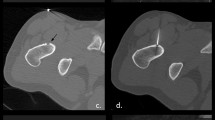Abstract
Purpose
We have been using radiofrequency ablation for the percutaneous treatment of osteoid osteoma since 2001. Frequently, lesions are located near the joint surface, involve the vertebral body or are close to major nerves. We seek to determine whether radiofrequency ablation (RFA) can be used safely in these cases.
Materials and methods
A total of 65 lesions were induced in 4 dogs. Each dog underwent RFA on the diaphysis of long bones, as well as femoral and humeral heads. Four different sessions were carried out by using 1- and 2-cm probes with or without a cool-tip system and by varying the timing of the procedure. Plain film, CT, and MRI were obtained. All bone samples were examined histologically.
Results
The dogs’ activity after the procedure was normal. No pathologic fractures occurred despite unrestricted activity of the animals. Cortical bone was always respected; therefore, articular cartilage has not been damaged. Radiological findings were characteristic. There were no significant differences in lesion size, probe type, and the duration of the procedure. The mean lesion diameter perpendicular to the electrode was 18.5 mm.
Conclusions
Our study confirms the insulative effect of cortical bone. RFA can be safely performed close to the joint surface without damaging the cartilage.









Similar content being viewed by others
References
Rosenthal DI, Alexander A, Rosenberg AE, Springfield D. Ablation of osteoid osteomas with a percutaneously placed electrode: a new procedure. Radiology 1992; 183: 29–33.
Tillotson CL, Rosenberg AE, Rosenthal DI. Controlled thermal injury of bone. Report of a percutaneous technique using radiofrequency electrode and generator. Invest Radiol 1989; 24: 888–892.
Dupuy DE, Hong R, Oliver B, Goldberg SN. Radiofrequency ablation of spinal tumors: temperature distribution in the spinal canal. AJR Am J Roentgenol 2000; 175: 1263–1266.
Nour SG, Aschoff AJ, Mitchell ICS, Emancipator SN, Duerk JL, Lewin JS. MR imaging-guided radiofrequency thermal ablation of the lumbar vertebrae in porcine models. Radiology 2002; 224: 452–461.
Aschoff AJ, Merkle EM, Emancipator SN, Petersilge CA, Duerk JL, Lewin JS. Femur: MR imaging-guided radiofrequency ablation in a porcine model. Feasibility study. Radiology 2002; 225: 471–478.
Takeda A, Kikuchi S, Tajino T, Yamada H, Sato K. Basic and clinical studies of percutaneous radiofrequency ablation of osteoid osteoma using a standard electrosurgical generator. J Orthop Sci 2003; 8: 301–305.
Houpt JC, Conner ES, McFarland EW. Experimental study of temperature distributions and thermal transport during radiofrequency current therapy of the intervertebral disc. Spine 1996; 21: 1808–1812.
Lundskog J. Heat and bone tissue, An experimental investigation of the thermal properties of bone and threshold levels for thermal injury. Scand J Plast Reconstr Surg 1972; 9 Suppl: 1–80.
Lee JM, Choi SH, Park HS, Lee MW, et al. Radiofrequency thermal ablation in canine femur: evaluation of coagulation necrosis reproducibility and MRI-histopathologic correlation. AJR Am J Roentgenol 2005; 185: 661–667.
Bitsch RG, Rupp R, Bernd L, Ludwig K. Osteoid osteoma in an ex vivo animal model: temperature changes in surrounding soft tissue during CT-guided radiofrequency ablation. Radiology 2006; 238: 107–112.
Rosenthal DI, Hornicek FJ, Torriani M, Gebhardt MC, Mankin HJ. Osteoid osteoma: percutaneous treatment with radiofrequency energy. Radiology 2003; 229: 171–175.
Pinto CH, Taminiau AHM, Vanderschueren GM, Hogendoorn PCW, Bloem JL, Obermann WR. Technical considerations in CT-guided radiofrequency thermal ablation of osteoid osteoma: tricks of the trade. AJR Am J Roentgenol 2003; 179: 1633–1642.
Tins B, Cassar-Pullicino V, McCall I, Cool P, Williams D, Mangham D. Radiofrequency ablation of chondroblastoma using a multi-tined expandable electrode system: initial results. Eur Radiol 2006; 16 4: 804–810.
Ramnath RR, Rosenthal DI, Cates J, Gebhardt M, Quinn RH. Intracortical chondromas simulating osteoid osteoma treated by radiofrequency. Skeletal Radiol 2002; 31: 597–602.
Callstrom MR, Charboneau JW, Goetz MP, et al. Painful metastases involving bone: feasibility of percutaneous CT- and US-guided radio-frequency ablation. Radiology 2002; 224: 87–97.
Rachbauer F, Mangat J, Bodner G, Eichberger P, Krismer M. Heat distribution and heat transport in bone during radiofrequency catheter ablation. Arch Orthop Trauma Surg 2003; 123: 86–90.
Cantwell CP, Kerr J, O’Byrne J, Eustace S. MRI features after radiofrequency ablation of osteoid osteoma with cooled probes and impedance-control energy delivery. AJR Am J Roentgenol 2006; 186: 1220–1227.
Goldberg SN, Gazelle GS, Dawson SL, Rittman WJ, Mueller PR, Rosenthal DI. Tissue ablation with radiofrequency: effect of probe size, gauge, duration and temperature on lesion volume. Acad Radiol 1995; 2: 399–404.
Goldberg SN, Gazelle GS, Solbiati L, Rittman WJ, Mueller PR. Radiofrequency tissue ablation: increased lesion diameter with a perfusion electrode. Acad Radiol 1996; 3: 636–644.
Author information
Authors and Affiliations
Corresponding author
Rights and permissions
About this article
Cite this article
Martel, J., Bueno, A., Domínguez, M.P. et al. Percutaneous radiofrequency ablation: relationship between different probe types and procedure time on length and extent of osteonecrosis in dog long bones. Skeletal Radiol 37, 147–152 (2008). https://doi.org/10.1007/s00256-007-0416-1
Received:
Revised:
Accepted:
Published:
Issue Date:
DOI: https://doi.org/10.1007/s00256-007-0416-1




